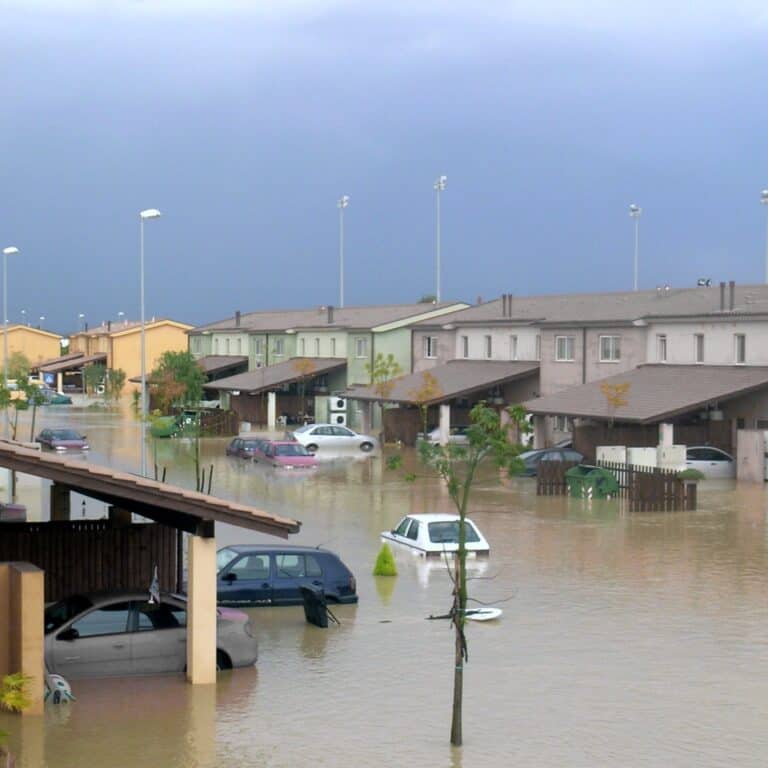
For preppers, being ready is a way of life and if you or a smart prepper you’ll get ready for natural disasters as the most likely major emergency.
Sure, it’s fun to think about a zombie apocalypse, but chances are we are going to have to deal with Mother Nature’s fury in lieu of anything else.
That said, some states are subjected to many more natural disasters than others, and if you want to increase your chances of a long and happy life, you might be best served to live in these places. So, which states have the fewest natural disasters?
The states with the fewest natural disasters according to Federal declarations are Vermont, Idaho, Michigan, Utah, Maryland, Wyoming, Connecticut, South Carolina, Rhode Island, and Delaware.
This is something of a contentious subject, because everybody’s definition for what constitutes a disaster is a little bit different, and that includes various state and government agencies.
But don’t worry about that, because I will explain the reasoning for my rankings below, and then tell you a little bit about why each of these states will help you live a long and quiet life.
Keep reading to learn more…
What Do We Mean by “Least” Disasters?
I know it sounds like a simple academic question, but this topic is deceptively complicated: What exactly constitutes a disaster?
You don’t need me to tell you what a natural disaster is, you already know, but when determining which state suffers from the fewest, or which ones suffer the least from natural disasters we have to dig a little bit deeper.
Are we looking for lives lost year to year? How about private property damage? Are we looking at the sheer number of occurrences in the state’s boundaries, and then adding them all together?
Not so easy, eh? How do you weight one state against another if it has lots of a given type of disaster, say wildfires for instance, but they’re rarely too big and even more rarely cause serious damage or deaths?
North Carolina is one such state; lots of fires, but they rarely add up to much side from some burned forest.
Would you put a state that has very few disasters yearly higher or lower on the list if those disasters tend to be huge and cataclysmically destructive?
Florida is a great example, as the state generally only has a few months to really worry over the most destructive storms, but those hurricanes are a doozy!
You can see where I’m going with this, and this is why I settled on what I believe to be an elegant solution.
I have ranked the states below, from most to least out of the states that already have the fewest disasters overall, according to how many times a federal disaster declaration was made.
When that happens, you know you’re genuinely dealing with a major catastrophe that’s highly likely to result in widespread damage, loss of life and serious societal disruption.
While it is true that some truly huge disasters that have happened over the years did not result in a federal declaration for a given state, I think these tend to be more the exception than the rule. Accordingly, I stand by my rankings below…
Without any further ado, let’s get to the list.
10. Vermont
Vermont is known for its predominantly libertarian policies, beautiful fall foliage, and a more or less agrarian or rural feel throughout the state when you are away from the few major towns and cities.
Vermont is also squarely in the middle of New England, a northern region of the United States that historically has been spared the worst disasters of any kind, and the pitifully few Federal declarations of disaster in the state reflect this, only 45 since 1953!
You can deal with proper disasters in Vermont, of course, and the state is highly prone to flooding in low-lying areas and near major bodies of water from heavy rains or substantial runoff from melting snow at the end of winter.
It can also catch plenty of flak from powerful nor’easters, basically polar hurricanes that dump tons of snow and powerful winds besides.
That being said, Vermont definitely seems to weather all of this, pun intended, just fine despite the destruction that these events sometimes cause.
You’re much better off taking your chances here than in many other states near the coasts!
9. Idaho
I’ll spare you the potato jokes, I feel like that well is dry. In Idaho, you won’t have nearly as many natural disasters to worry about as you will in other states.
Wildfires are a concern, most particularly during the summer months or any other times of drought, though they do occur periodically throughout the year. Idaho also gets its fair share of severe thunderstorms, and some harsh winter weather.
That being said, you usually don’t hear Idaho mentioned in the news referring to some catastrophic disaster because, most of the time, they just don’t happen there.
Sure, any number of things can go wrong at the local level, but serious regional disasters are quite rare comparatively.
The federal government thinks so too, considering there’ve only been 44 federally declared disasters in the past 70 years.
There’s no reason to get lazy if you’re a prepper who is living in Idaho or considering a move, but you should take confidence from the fact that you’ll probably avoid most of the pandemonium that takes place in the rest of the country.
8. Michigan
Michigan is another state that might seem like a peculiar inclusion on this list. After all, Michigan is known for getting rocked by intense winter weather, gnarly storms rolling in off the Great Lakes, and even some pretty intense hail from time to time. What gives, isn’t it disaster-prone?
No, as it turns out, it isn’t. Once again, most of these disasters and severe weather events are locally destructive or might even cause a statewide chaos, but they’re rarely so severe as to require Federal help for resolution.
Even better, despite all of the stormy weather, Michigan rarely experiences tornadoes.
However, you’ll need to be concerned with flooding pretty much anywhere you live in the state, though even the most legendary floods that have taken place in Michigan or nowhere near as bad as some of the mega floods that have taken place in other states.
Once again, consulting the federal disaster declarations from the past seven decades that we see that only 37 have been declared in Michigan. Not too bad at all!
If you can put up with cold, dreary weather, and can plan accordingly to deal with it (a.k.a. stay put), you should have an easy go of it in Michigan.
7. Utah
This is another surprising inclusion, because to some folks Utah is known for being a pretty active state concerning natural disasters.
Seems like you’re always hearing about some sort of severe storm, landslide or earthquake out there so what gives?
Like all of the other states on this list, there have been very, very few Federal disaster declarations in Utah- just 34 in the past 70 years- but that’s only part of the explanation.
The other part is that most of these disasters, including the earthquakes, just don’t result in that much damage or major disruption to life and society within the state.
Yes, Utah experiences significantly higher than average seismic activity. Yes, some severe storms can routinely lead to significant flooding or even direct damage from strong winds and lightning.
All of this is true but it still doesn’t account for very much considering how little damage overall Utah suffers.
Most emergencies, wherever and however they occur, are limited to the local or near regional level, and they are typically quickly resolved.
You might have to put up with the occasional drought and strong thunderstorm, not to mention an earthquake you are actually able to feel every few years, however slight, but life is generally peaceful as far as natural disasters are concerned in the state.
6. Maryland
Now we’re getting into the states where disasters are truly scarce! Coming in sixth place with a measly 32 Federal disaster declarations, Maryland is often impacted by seasonal storms, including hurricanes coming up from the south and nor’easters from the north.
These naturally lead to considerable flooding and often plenty of damage, but compared to many other states situated along the seaboard, Maryland typically gets off pretty easy.
Other than these storms and associated flood events, Maryland doesn’t experience a much else in the way of significant natural disasters…
5. Wyoming
A state known for wide open spaces and being practically devoid of people with just a little more than half a million residents in total, Wyoming is virtually synonymous with self-sufficiency and a harsh yet serene beauty.
It is also known for equally harsh and beautiful winter weather, hail and severe storms, as any long-time resident will tell you.
Wyoming is tied with Maryland with 32 Federal disaster declarations since 1953, but just edges out that state because the population density and landlocked nature of Wyoming means that the impact of even these severe storms is typically less destructive overall.
4. Connecticut
Nestled in the heart of “Yankeedom” on the Atlantic Ocean, Connecticut is certainly vulnerable to the same nor’easters and occasional hurricane that much of New England is.
But the difference between Connecticut and most of those other lower states is the former typically doesn’t suffer much damage (unless it’s from a whopper storm in the middle of winter).
Even so, Connecticut is nowhere near as hard hit from these events, historically, as other states in the region and other coastally situated ones in the American Deep South. A meager 31 Federal disaster declarations in 70 years is a testament to that.
3. South Carolina
South Carolina is right in the middle of the Eastern Seaboard, and as such the state has been bombarded by hurricanes over the years and the occasional remnants of a nor’easter that makes its way down past New England.
Tropical storms are also a perennial threat during the season. Considering the damage and death toll that these storms rack up, the high rating that South Carolina obtains on our list seems suspect to say the least.
But I disagree: even though every so often down the years a truly monster storm will wreak incredible havoc along the coast itself and occasionally farther inland, this is rarely so bad that the state is unable to provide adequate relief and get things fixed up.
This is readily evidenced by the tiny number of Federal disaster declarations: just 30 in the last 7 decades!
This is a proof to me of South Carolina’s resiliency, but also proof that outside of the occasional rogue storm you won’t have too much to worry about in the state.
2. Rhode Island
Teeny tiny Rhode Island is easily forgotten, but it really does experience an almost insignificant amount of disasters if you’re going by the federal declarations over the years. Just 22 since 1953!
As expected, being situated right along the coast with so many of our other Northern states, nor’easters, hurricanes, the occasional severe thunderstorm and the flooding associated with all of them is definitely a concern, and they do cause considerable damage.
However, events that the state is unable to deal with to keep society functioning are comparatively quite rare.
1. Delaware
Last on our list but first among states when it comes to a lack of natural disasters is Delaware. Crammed in between Maryland and New Jersey, looking highly vulnerable protruding as it does out into the ocean, Delaware nonetheless fares quite well considering the pounding it gets from seasonal storm systems.
Whether it’s a winter storm, a proper nor’easter, a hurricane or the remnants thereof, Delaware rarely gets all broken up from natural disasters.
Unbelievably, the federal government has declared disaster over only 21 times in 70 years.
Tom Marlowe practically grew up with a gun in his hand, and has held all kinds of jobs in the gun industry: range safety, sales, instruction and consulting, Tom has the experience to help civilian shooters figure out what will work best for them.



